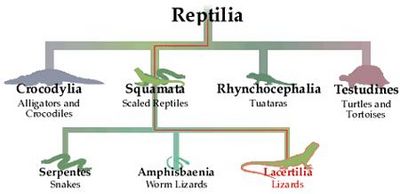Snake Taxonomy
| This article is still under construction. |
Introduction
Snakes are the most recently evolved group of reptiles and have numerous specialisations that distinguish them from other squamates (scaled reptiles). Their musculoskeletal system is adapted for creeping, burrowing, swimming and gliding. Chemo and thermoreceptors are a key feature in their methods of predation, in addition to extreme cranial kinesis and, in some species, deadly venoms.
Evolution and Taxonomy
Snakes are members of the class Reptilia and order Squamata (scaled reptiles). Squamata is made up of the suborders Serpentes (snakes) and Sauria (lizards). Snakes are the most recently evolved group of reptiles. Their fossil record is limited due to their fragile skeletons, however recent discoveries of early fossil snakes with posterior legs has generated debate about the origins of their evolution.
| Family | Genera | ||
|---|---|---|---|
| Primitive Snakes | Anomalepididae | Blind snakes | 4 |
| Infraorder | Typhlopidae | Blind worm snakes | 3 |
| Scolecophidia | Leptotyphlopidae | Slender blind snakes | 2 |
| Advanced Snakes | |||
| Infraorder | Acrochordidae | File snakes | 1 |
| Alethinophidia | Aniliidae | Coral pipe snakes | 1 |
| Atractaspididae | Mole vipers | 1 | |
| Boidae | Boas and pythons | 23 | |
| Bolyeriidae | Round Island ‘boas’ | 2 | |
| Colubridae | Advanced snakes | 303 | |
| Elapidae | Cobras, kraits and sea snakes | 60 | |
| Loxocemidae | Mexican burrowing pythons | 1 | |
| Uropeltidae | Short-tail snakes | 10 | |
| Viperidae | Vipers | 28 | |
| Xenopeltidae | Sunbeam snake | 1 |
